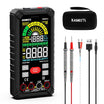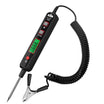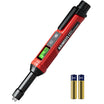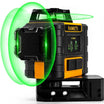Solar panels are a great way to generate electricity, but they can be expensive. If you're thinking about purchasing solar panels, it's important to know how to test them before you make your purchase. A KAIWEETS digital multimeter is a valuable tool that can help you test solar panels and ensure that they are working properly.
What is a solar panel, and how does it work?
A solar panel is a device that converts sunlight into electricity. It is typically made of semiconductor materials like silicon. When light hits the solar panel, it creates an electric field across the layers of silicon. This causes electrons to flow from one side of the solar panel to the other, creating an electric current. The current can then be used to power electrical devices.
Solar panels are often used to generate electricity for homes and businesses. They can also be used to power road signs, calculators, and even spacecraft! Solar panels are a clean and renewable source of energy, and their usage is growing rapidly around the world.
How do solar panels work?
Solar panels are made up of photovoltaic cells, which convert sunlight into electricity. Each cell is made of semiconductor materials like silicon. When light hits the cell, it creates an electric field across the layers of silicon. This causes electrons to flow from one side of the cell to the other, creating an electric current. The current can then be used to power electrical devices.
Solar panels are often used to generate electricity for homes and businesses. They can also be used to power road signs, calculators, and even spacecraft! Solar panels are a clean and renewable source of energy, and their usage is growing rapidly around the world. Thanks for reading! We hope this article has helped you understand how solar panels work.
How to test solar panels with a multimeter?
It is essential to test your solar panel with a KAIWEETS digital multimeter to get the most out of your solar panel. There are numerous advantages to doing so, including ensuring that the solar panel is producing the appropriate amount of power and that there are no shorts in the circuit. To use a multimeter to test the solar panel:
- Set your multimeter to the "DC Voltage" setting.
- Connect the positive lead of your multimeter to the positive terminal of the solar panel, and connect the negative lead of your multimeter to the negative terminal of the solar panel.
- Take a reading from your multimeter. This is the voltage output of the solar panel.
- Repeat steps 2 and 3 for each solar panel in your system.
- Compare the readings from your multimeter to the rated voltage of your solar panels. The voltage output of your solar panels should be within 10% of the rated voltage.
If the voltage output of your solar panels is outside of this range, it could indicate that the panels are not working correctly. You should contact a qualified solar installer or electrician to diagnose and fix the problem.
Frequently Asked Questions:
What should the voltage be on a solar panel?
There is no definitive answer to this question as the voltage of a solar panel can vary depending on several factors, such as the type of solar panel, the size of the panel, and the conditions under which it is being used. However, as a general rule of thumb, the voltage of a solar panel should be around 12 volts to produce enough power for most applications. If you are using a solar panel for a specific application that requires more or less power, then you may need to adjust the voltage accordingly.
How can you tell if a solar panel is faulty?
If you have a solar panel, it's important to know how to tell if it's not working properly. There are a few signs that you can look for that will indicate that your solar panel is faulty.
- Check to see if the panel is receiving direct sunlight. If the panel is in an area that is shaded or obstructed by something like trees or buildings, then it will not be able to produce as much power as it could if it was in full sun.
- Check the condition of the solar panel itself. If there are any cracks or damaged areas on the panel, this could affect its ability to function properly.
- Check the connections between the solar panel and the rest of your system. If any of the wires are loose or damaged, this could also cause problems.
If you notice any of these signs, it's important to have your solar panel checked by a professional to make sure that it's still working properly. In some cases, it may be necessary to replace the solar panel if it is no longer able to function correctly.
How frequently should solar panels be replaced?
It depends on the type of solar panel and the environment in which it is used. Solar panels can last for decades, but they may need to be replaced sooner if they are exposed to harsh conditions or if they are not maintained properly. The average lifespan of a solar panel is 20-25 years. However, some solar panels may need to be replaced after 10-15 years due to damage or degradation.
Conclusion:
In conclusion, testing your solar panel with a kaiweets digital multimeter is a relatively simple process. By following the steps outlined in this article, you can easily test the output of your solar panel and ensure that it is functioning properly. With a little bit of practice, you'll be able to quickly and easily test your solar panels at home, on the go, or anywhere else. Thanks for reading!



































































Leave a comment
All comments are moderated before being published.
This site is protected by hCaptcha and the hCaptcha Privacy Policy and Terms of Service apply.